NSB202: Aboriginal and Torres Strait Islander Peoples' Wellbeing Essay
VerifiedAdded on 2023/01/12
|10
|2766
|395
Essay
AI Summary
This essay examines the wellbeing of Aboriginal and Torres Strait Islander peoples within the context of the Australian healthcare system. It explores the concepts of personal and institutional racism, detailing how power dynamics, particularly those associated with 'whiteness,' contribute to healthcare disparities. The essay delves into the significance of cultural safety in nursing practice, contrasting it with cultural competence and emphasizing the need for healthcare providers to understand and address historical, social, economic, and political factors affecting Indigenous health. The author reflects on their initial assumptions and the insights gained from the course materials, highlighting the poor health status of Aboriginal Australians and the impact of systemic racism. It further discusses the achievements and ongoing efforts in the healthcare sector to incorporate culturally safe nursing practices. The essay emphasizes the importance of addressing the challenges of institutional racism and promoting cultural safety to improve healthcare outcomes for Aboriginal and Torres Strait Islander peoples. It concludes by highlighting the role of nurses in advocating for culturally safe practices and fostering collaborative frameworks within the healthcare system.
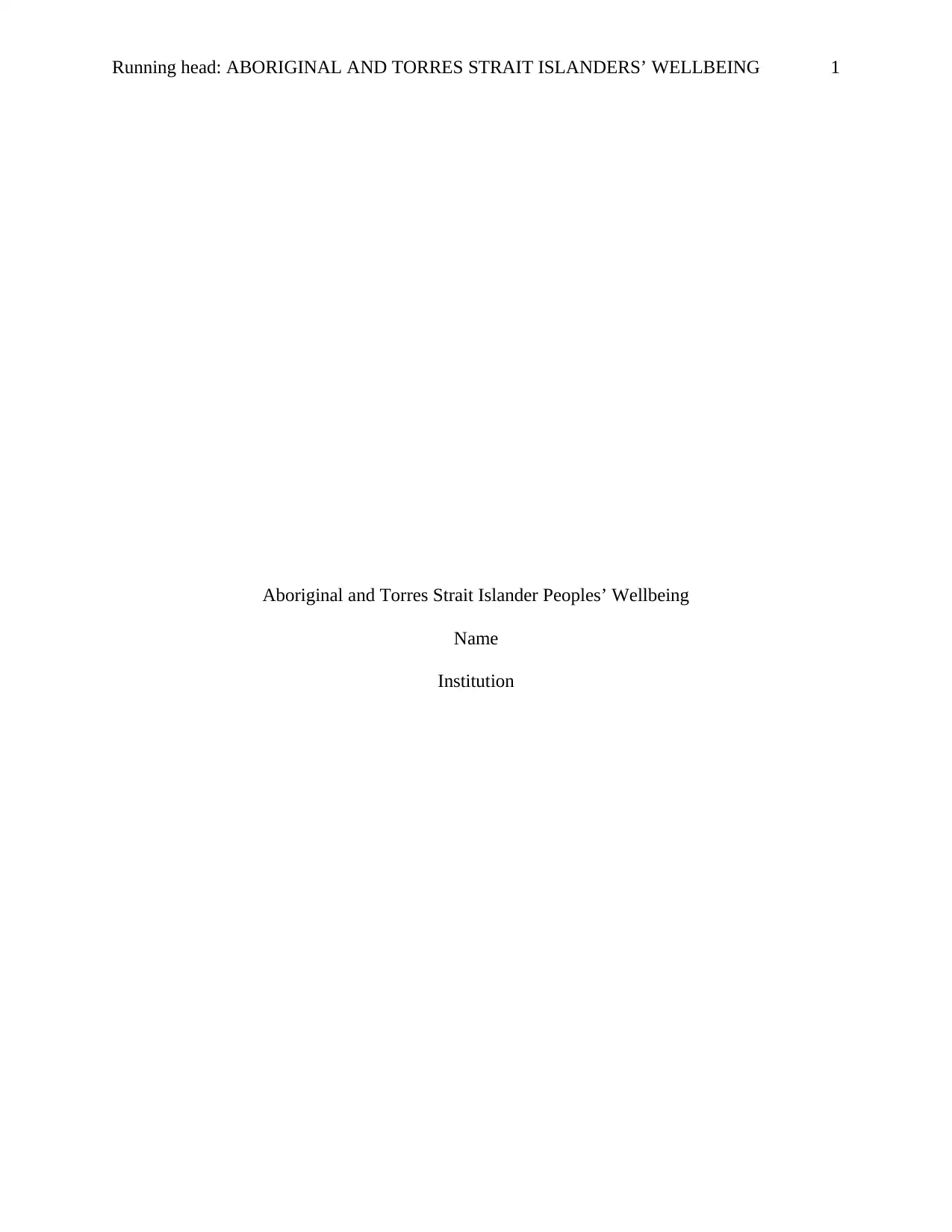
Running head: ABORIGINAL AND TORRES STRAIT ISLANDERS’ WELLBEING 1
Aboriginal and Torres Strait Islander Peoples’ Wellbeing
Name
Institution
Aboriginal and Torres Strait Islander Peoples’ Wellbeing
Name
Institution
Paraphrase This Document
Need a fresh take? Get an instant paraphrase of this document with our AI Paraphraser
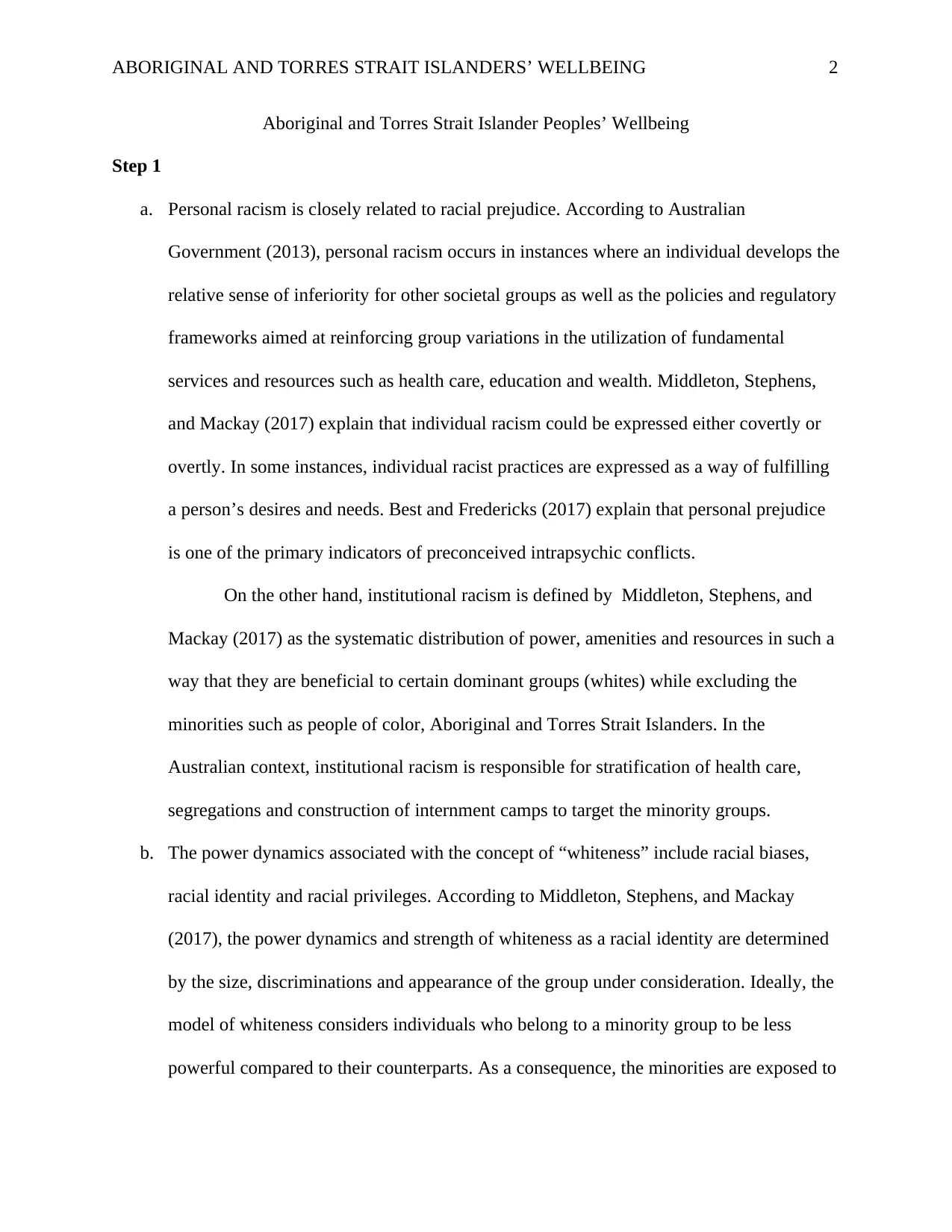
ABORIGINAL AND TORRES STRAIT ISLANDERS’ WELLBEING 2
Aboriginal and Torres Strait Islander Peoples’ Wellbeing
Step 1
a. Personal racism is closely related to racial prejudice. According to Australian
Government (2013), personal racism occurs in instances where an individual develops the
relative sense of inferiority for other societal groups as well as the policies and regulatory
frameworks aimed at reinforcing group variations in the utilization of fundamental
services and resources such as health care, education and wealth. Middleton, Stephens,
and Mackay (2017) explain that individual racism could be expressed either covertly or
overtly. In some instances, individual racist practices are expressed as a way of fulfilling
a person’s desires and needs. Best and Fredericks (2017) explain that personal prejudice
is one of the primary indicators of preconceived intrapsychic conflicts.
On the other hand, institutional racism is defined by Middleton, Stephens, and
Mackay (2017) as the systematic distribution of power, amenities and resources in such a
way that they are beneficial to certain dominant groups (whites) while excluding the
minorities such as people of color, Aboriginal and Torres Strait Islanders. In the
Australian context, institutional racism is responsible for stratification of health care,
segregations and construction of internment camps to target the minority groups.
b. The power dynamics associated with the concept of “whiteness” include racial biases,
racial identity and racial privileges. According to Middleton, Stephens, and Mackay
(2017), the power dynamics and strength of whiteness as a racial identity are determined
by the size, discriminations and appearance of the group under consideration. Ideally, the
model of whiteness considers individuals who belong to a minority group to be less
powerful compared to their counterparts. As a consequence, the minorities are exposed to
Aboriginal and Torres Strait Islander Peoples’ Wellbeing
Step 1
a. Personal racism is closely related to racial prejudice. According to Australian
Government (2013), personal racism occurs in instances where an individual develops the
relative sense of inferiority for other societal groups as well as the policies and regulatory
frameworks aimed at reinforcing group variations in the utilization of fundamental
services and resources such as health care, education and wealth. Middleton, Stephens,
and Mackay (2017) explain that individual racism could be expressed either covertly or
overtly. In some instances, individual racist practices are expressed as a way of fulfilling
a person’s desires and needs. Best and Fredericks (2017) explain that personal prejudice
is one of the primary indicators of preconceived intrapsychic conflicts.
On the other hand, institutional racism is defined by Middleton, Stephens, and
Mackay (2017) as the systematic distribution of power, amenities and resources in such a
way that they are beneficial to certain dominant groups (whites) while excluding the
minorities such as people of color, Aboriginal and Torres Strait Islanders. In the
Australian context, institutional racism is responsible for stratification of health care,
segregations and construction of internment camps to target the minority groups.
b. The power dynamics associated with the concept of “whiteness” include racial biases,
racial identity and racial privileges. According to Middleton, Stephens, and Mackay
(2017), the power dynamics and strength of whiteness as a racial identity are determined
by the size, discriminations and appearance of the group under consideration. Ideally, the
model of whiteness considers individuals who belong to a minority group to be less
powerful compared to their counterparts. As a consequence, the minorities are exposed to
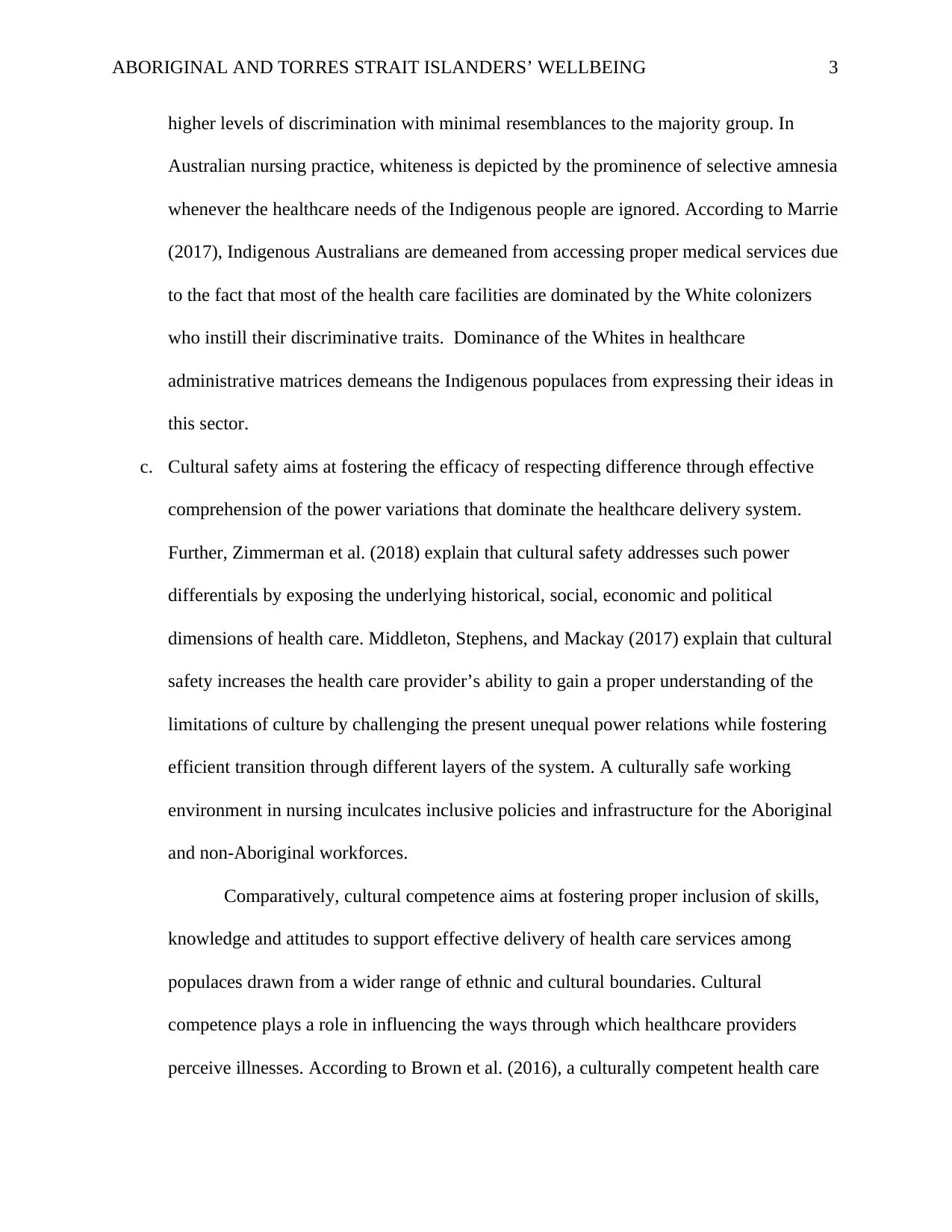
ABORIGINAL AND TORRES STRAIT ISLANDERS’ WELLBEING 3
higher levels of discrimination with minimal resemblances to the majority group. In
Australian nursing practice, whiteness is depicted by the prominence of selective amnesia
whenever the healthcare needs of the Indigenous people are ignored. According to Marrie
(2017), Indigenous Australians are demeaned from accessing proper medical services due
to the fact that most of the health care facilities are dominated by the White colonizers
who instill their discriminative traits. Dominance of the Whites in healthcare
administrative matrices demeans the Indigenous populaces from expressing their ideas in
this sector.
c. Cultural safety aims at fostering the efficacy of respecting difference through effective
comprehension of the power variations that dominate the healthcare delivery system.
Further, Zimmerman et al. (2018) explain that cultural safety addresses such power
differentials by exposing the underlying historical, social, economic and political
dimensions of health care. Middleton, Stephens, and Mackay (2017) explain that cultural
safety increases the health care provider’s ability to gain a proper understanding of the
limitations of culture by challenging the present unequal power relations while fostering
efficient transition through different layers of the system. A culturally safe working
environment in nursing inculcates inclusive policies and infrastructure for the Aboriginal
and non-Aboriginal workforces.
Comparatively, cultural competence aims at fostering proper inclusion of skills,
knowledge and attitudes to support effective delivery of health care services among
populaces drawn from a wider range of ethnic and cultural boundaries. Cultural
competence plays a role in influencing the ways through which healthcare providers
perceive illnesses. According to Brown et al. (2016), a culturally competent health care
higher levels of discrimination with minimal resemblances to the majority group. In
Australian nursing practice, whiteness is depicted by the prominence of selective amnesia
whenever the healthcare needs of the Indigenous people are ignored. According to Marrie
(2017), Indigenous Australians are demeaned from accessing proper medical services due
to the fact that most of the health care facilities are dominated by the White colonizers
who instill their discriminative traits. Dominance of the Whites in healthcare
administrative matrices demeans the Indigenous populaces from expressing their ideas in
this sector.
c. Cultural safety aims at fostering the efficacy of respecting difference through effective
comprehension of the power variations that dominate the healthcare delivery system.
Further, Zimmerman et al. (2018) explain that cultural safety addresses such power
differentials by exposing the underlying historical, social, economic and political
dimensions of health care. Middleton, Stephens, and Mackay (2017) explain that cultural
safety increases the health care provider’s ability to gain a proper understanding of the
limitations of culture by challenging the present unequal power relations while fostering
efficient transition through different layers of the system. A culturally safe working
environment in nursing inculcates inclusive policies and infrastructure for the Aboriginal
and non-Aboriginal workforces.
Comparatively, cultural competence aims at fostering proper inclusion of skills,
knowledge and attitudes to support effective delivery of health care services among
populaces drawn from a wider range of ethnic and cultural boundaries. Cultural
competence plays a role in influencing the ways through which healthcare providers
perceive illnesses. According to Brown et al. (2016), a culturally competent health care
⊘ This is a preview!⊘
Do you want full access?
Subscribe today to unlock all pages.

Trusted by 1+ million students worldwide
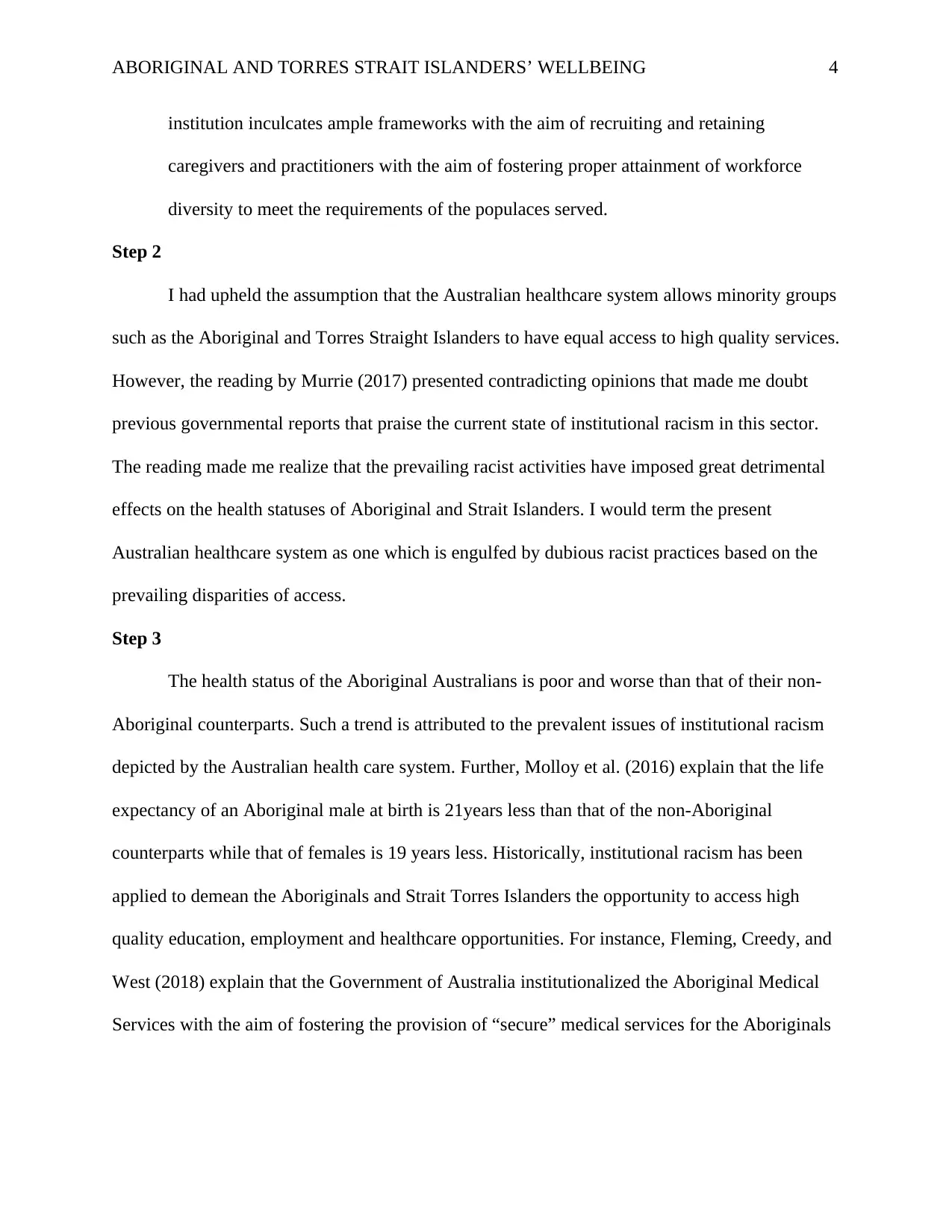
ABORIGINAL AND TORRES STRAIT ISLANDERS’ WELLBEING 4
institution inculcates ample frameworks with the aim of recruiting and retaining
caregivers and practitioners with the aim of fostering proper attainment of workforce
diversity to meet the requirements of the populaces served.
Step 2
I had upheld the assumption that the Australian healthcare system allows minority groups
such as the Aboriginal and Torres Straight Islanders to have equal access to high quality services.
However, the reading by Murrie (2017) presented contradicting opinions that made me doubt
previous governmental reports that praise the current state of institutional racism in this sector.
The reading made me realize that the prevailing racist activities have imposed great detrimental
effects on the health statuses of Aboriginal and Strait Islanders. I would term the present
Australian healthcare system as one which is engulfed by dubious racist practices based on the
prevailing disparities of access.
Step 3
The health status of the Aboriginal Australians is poor and worse than that of their non-
Aboriginal counterparts. Such a trend is attributed to the prevalent issues of institutional racism
depicted by the Australian health care system. Further, Molloy et al. (2016) explain that the life
expectancy of an Aboriginal male at birth is 21years less than that of the non-Aboriginal
counterparts while that of females is 19 years less. Historically, institutional racism has been
applied to demean the Aboriginals and Strait Torres Islanders the opportunity to access high
quality education, employment and healthcare opportunities. For instance, Fleming, Creedy, and
West (2018) explain that the Government of Australia institutionalized the Aboriginal Medical
Services with the aim of fostering the provision of “secure” medical services for the Aboriginals
institution inculcates ample frameworks with the aim of recruiting and retaining
caregivers and practitioners with the aim of fostering proper attainment of workforce
diversity to meet the requirements of the populaces served.
Step 2
I had upheld the assumption that the Australian healthcare system allows minority groups
such as the Aboriginal and Torres Straight Islanders to have equal access to high quality services.
However, the reading by Murrie (2017) presented contradicting opinions that made me doubt
previous governmental reports that praise the current state of institutional racism in this sector.
The reading made me realize that the prevailing racist activities have imposed great detrimental
effects on the health statuses of Aboriginal and Strait Islanders. I would term the present
Australian healthcare system as one which is engulfed by dubious racist practices based on the
prevailing disparities of access.
Step 3
The health status of the Aboriginal Australians is poor and worse than that of their non-
Aboriginal counterparts. Such a trend is attributed to the prevalent issues of institutional racism
depicted by the Australian health care system. Further, Molloy et al. (2016) explain that the life
expectancy of an Aboriginal male at birth is 21years less than that of the non-Aboriginal
counterparts while that of females is 19 years less. Historically, institutional racism has been
applied to demean the Aboriginals and Strait Torres Islanders the opportunity to access high
quality education, employment and healthcare opportunities. For instance, Fleming, Creedy, and
West (2018) explain that the Government of Australia institutionalized the Aboriginal Medical
Services with the aim of fostering the provision of “secure” medical services for the Aboriginals
Paraphrase This Document
Need a fresh take? Get an instant paraphrase of this document with our AI Paraphraser
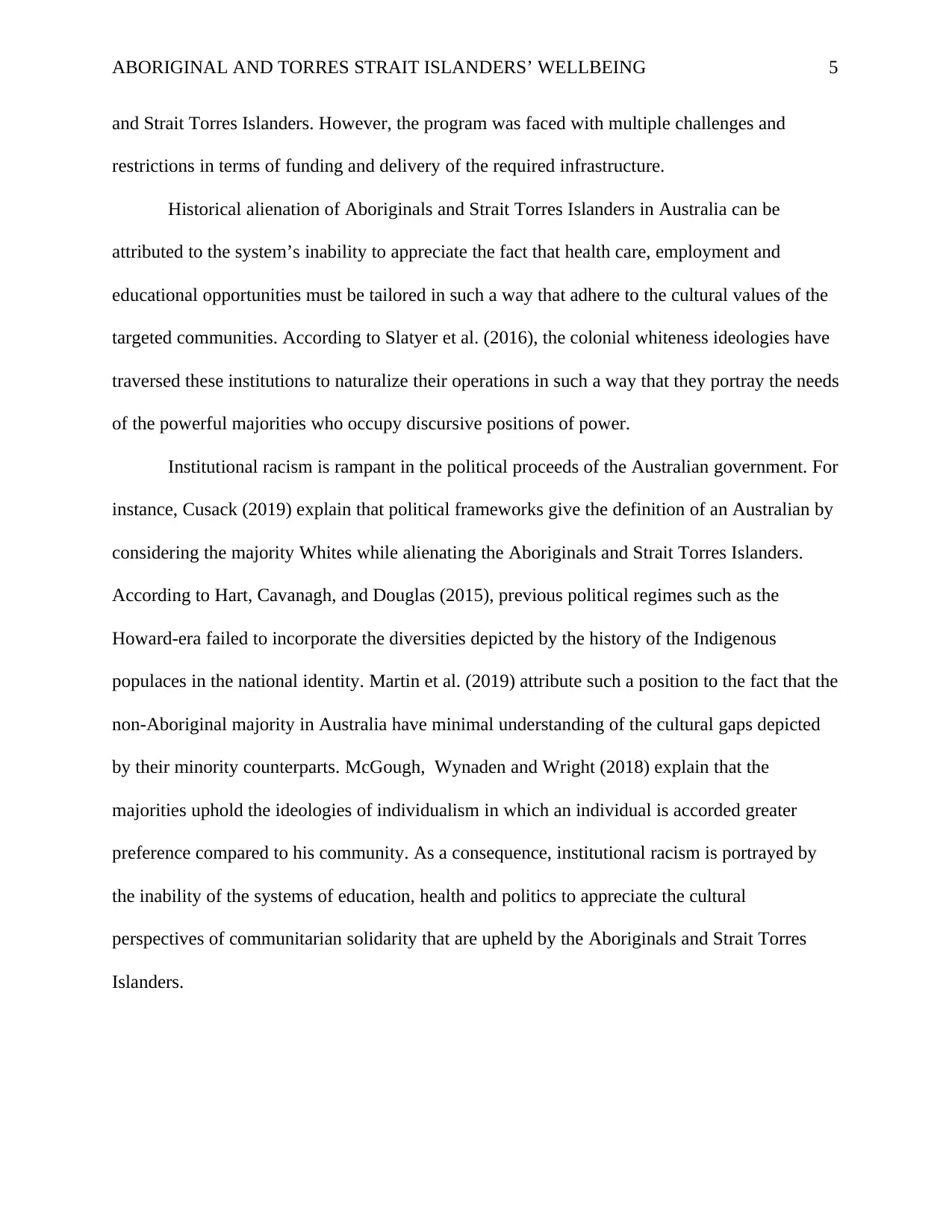
ABORIGINAL AND TORRES STRAIT ISLANDERS’ WELLBEING 5
and Strait Torres Islanders. However, the program was faced with multiple challenges and
restrictions in terms of funding and delivery of the required infrastructure.
Historical alienation of Aboriginals and Strait Torres Islanders in Australia can be
attributed to the system’s inability to appreciate the fact that health care, employment and
educational opportunities must be tailored in such a way that adhere to the cultural values of the
targeted communities. According to Slatyer et al. (2016), the colonial whiteness ideologies have
traversed these institutions to naturalize their operations in such a way that they portray the needs
of the powerful majorities who occupy discursive positions of power.
Institutional racism is rampant in the political proceeds of the Australian government. For
instance, Cusack (2019) explain that political frameworks give the definition of an Australian by
considering the majority Whites while alienating the Aboriginals and Strait Torres Islanders.
According to Hart, Cavanagh, and Douglas (2015), previous political regimes such as the
Howard-era failed to incorporate the diversities depicted by the history of the Indigenous
populaces in the national identity. Martin et al. (2019) attribute such a position to the fact that the
non-Aboriginal majority in Australia have minimal understanding of the cultural gaps depicted
by their minority counterparts. McGough, Wynaden and Wright (2018) explain that the
majorities uphold the ideologies of individualism in which an individual is accorded greater
preference compared to his community. As a consequence, institutional racism is portrayed by
the inability of the systems of education, health and politics to appreciate the cultural
perspectives of communitarian solidarity that are upheld by the Aboriginals and Strait Torres
Islanders.
and Strait Torres Islanders. However, the program was faced with multiple challenges and
restrictions in terms of funding and delivery of the required infrastructure.
Historical alienation of Aboriginals and Strait Torres Islanders in Australia can be
attributed to the system’s inability to appreciate the fact that health care, employment and
educational opportunities must be tailored in such a way that adhere to the cultural values of the
targeted communities. According to Slatyer et al. (2016), the colonial whiteness ideologies have
traversed these institutions to naturalize their operations in such a way that they portray the needs
of the powerful majorities who occupy discursive positions of power.
Institutional racism is rampant in the political proceeds of the Australian government. For
instance, Cusack (2019) explain that political frameworks give the definition of an Australian by
considering the majority Whites while alienating the Aboriginals and Strait Torres Islanders.
According to Hart, Cavanagh, and Douglas (2015), previous political regimes such as the
Howard-era failed to incorporate the diversities depicted by the history of the Indigenous
populaces in the national identity. Martin et al. (2019) attribute such a position to the fact that the
non-Aboriginal majority in Australia have minimal understanding of the cultural gaps depicted
by their minority counterparts. McGough, Wynaden and Wright (2018) explain that the
majorities uphold the ideologies of individualism in which an individual is accorded greater
preference compared to his community. As a consequence, institutional racism is portrayed by
the inability of the systems of education, health and politics to appreciate the cultural
perspectives of communitarian solidarity that are upheld by the Aboriginals and Strait Torres
Islanders.

ABORIGINAL AND TORRES STRAIT ISLANDERS’ WELLBEING 6
Step 4
The health care sector in Australia has made significant achievements in its efforts of
incorporating culturally safe nursing practices as a way of ensuring that the Aboriginals and
Strait Torres Islanders gain access to the desired services. For instance, Cox (2016) explain that
nurses in Australian health care institutions have inculcated a critical emphasis on the importance
of cultural safety as a way of fostering cultural changes at individual and institutional levels.
According to Fleming, Creedy, and West (2018) Aboriginals and Strait Torres Islanders are
demeaned from experiencing the desired levels of cultural safety without proper
institutionalization of change at the institutional and personal levels. For instance, Australian
Government (2013) explain that nursing and midwifery professional in Australia foster the
ideologies of cultural safety by revealing higher levels of reflexivity through development of
optimal degrees of self awareness.
Institutional cultural safety in the Australian nursing profession is developed among
nurses and midwives through proper recognition of the extents to which the aspects of whiteness,
white power and privileges are rooted in the country’s health care and educational frameworks.
According to Cusack (2019) members of the nursing profession approach such impediments by
identifying the techniques required to deal with the societal and institutional challenges that
disrupt the ways of conducting business by decolonizing the system, services, and infrastructure.
Molloy et al. (2016) explain that nurses achieve this by embracing the imperative recognition of
the fact that whiteness is not only an element of skin color but also a conventionally set mind
frame of power and privilege while “blackness” is a spirit and an enduring culture. Such a notion
should be based on the premise that the health status of Aboriginals and Strait Torres Islanders is
Step 4
The health care sector in Australia has made significant achievements in its efforts of
incorporating culturally safe nursing practices as a way of ensuring that the Aboriginals and
Strait Torres Islanders gain access to the desired services. For instance, Cox (2016) explain that
nurses in Australian health care institutions have inculcated a critical emphasis on the importance
of cultural safety as a way of fostering cultural changes at individual and institutional levels.
According to Fleming, Creedy, and West (2018) Aboriginals and Strait Torres Islanders are
demeaned from experiencing the desired levels of cultural safety without proper
institutionalization of change at the institutional and personal levels. For instance, Australian
Government (2013) explain that nursing and midwifery professional in Australia foster the
ideologies of cultural safety by revealing higher levels of reflexivity through development of
optimal degrees of self awareness.
Institutional cultural safety in the Australian nursing profession is developed among
nurses and midwives through proper recognition of the extents to which the aspects of whiteness,
white power and privileges are rooted in the country’s health care and educational frameworks.
According to Cusack (2019) members of the nursing profession approach such impediments by
identifying the techniques required to deal with the societal and institutional challenges that
disrupt the ways of conducting business by decolonizing the system, services, and infrastructure.
Molloy et al. (2016) explain that nurses achieve this by embracing the imperative recognition of
the fact that whiteness is not only an element of skin color but also a conventionally set mind
frame of power and privilege while “blackness” is a spirit and an enduring culture. Such a notion
should be based on the premise that the health status of Aboriginals and Strait Torres Islanders is
⊘ This is a preview!⊘
Do you want full access?
Subscribe today to unlock all pages.

Trusted by 1+ million students worldwide
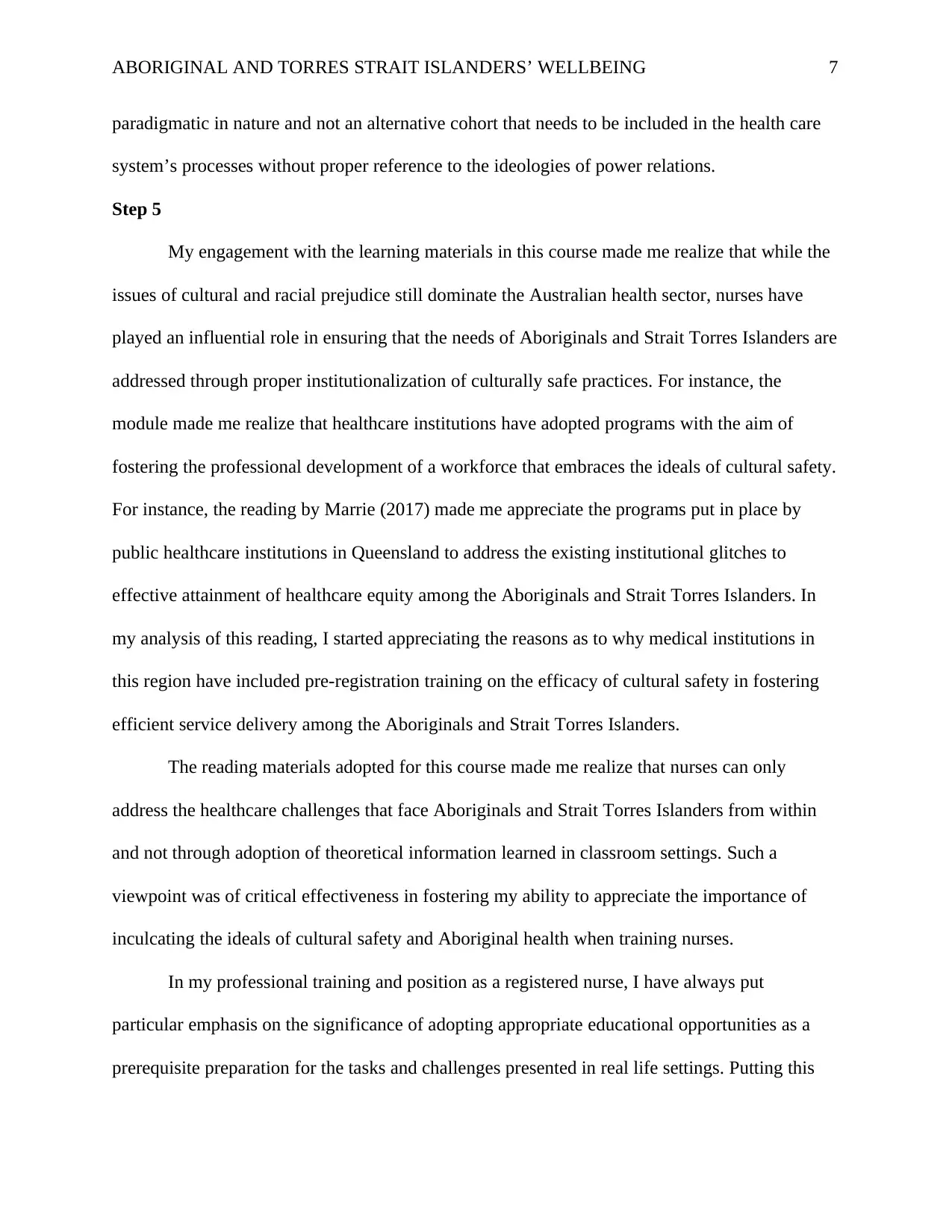
ABORIGINAL AND TORRES STRAIT ISLANDERS’ WELLBEING 7
paradigmatic in nature and not an alternative cohort that needs to be included in the health care
system’s processes without proper reference to the ideologies of power relations.
Step 5
My engagement with the learning materials in this course made me realize that while the
issues of cultural and racial prejudice still dominate the Australian health sector, nurses have
played an influential role in ensuring that the needs of Aboriginals and Strait Torres Islanders are
addressed through proper institutionalization of culturally safe practices. For instance, the
module made me realize that healthcare institutions have adopted programs with the aim of
fostering the professional development of a workforce that embraces the ideals of cultural safety.
For instance, the reading by Marrie (2017) made me appreciate the programs put in place by
public healthcare institutions in Queensland to address the existing institutional glitches to
effective attainment of healthcare equity among the Aboriginals and Strait Torres Islanders. In
my analysis of this reading, I started appreciating the reasons as to why medical institutions in
this region have included pre-registration training on the efficacy of cultural safety in fostering
efficient service delivery among the Aboriginals and Strait Torres Islanders.
The reading materials adopted for this course made me realize that nurses can only
address the healthcare challenges that face Aboriginals and Strait Torres Islanders from within
and not through adoption of theoretical information learned in classroom settings. Such a
viewpoint was of critical effectiveness in fostering my ability to appreciate the importance of
inculcating the ideals of cultural safety and Aboriginal health when training nurses.
In my professional training and position as a registered nurse, I have always put
particular emphasis on the significance of adopting appropriate educational opportunities as a
prerequisite preparation for the tasks and challenges presented in real life settings. Putting this
paradigmatic in nature and not an alternative cohort that needs to be included in the health care
system’s processes without proper reference to the ideologies of power relations.
Step 5
My engagement with the learning materials in this course made me realize that while the
issues of cultural and racial prejudice still dominate the Australian health sector, nurses have
played an influential role in ensuring that the needs of Aboriginals and Strait Torres Islanders are
addressed through proper institutionalization of culturally safe practices. For instance, the
module made me realize that healthcare institutions have adopted programs with the aim of
fostering the professional development of a workforce that embraces the ideals of cultural safety.
For instance, the reading by Marrie (2017) made me appreciate the programs put in place by
public healthcare institutions in Queensland to address the existing institutional glitches to
effective attainment of healthcare equity among the Aboriginals and Strait Torres Islanders. In
my analysis of this reading, I started appreciating the reasons as to why medical institutions in
this region have included pre-registration training on the efficacy of cultural safety in fostering
efficient service delivery among the Aboriginals and Strait Torres Islanders.
The reading materials adopted for this course made me realize that nurses can only
address the healthcare challenges that face Aboriginals and Strait Torres Islanders from within
and not through adoption of theoretical information learned in classroom settings. Such a
viewpoint was of critical effectiveness in fostering my ability to appreciate the importance of
inculcating the ideals of cultural safety and Aboriginal health when training nurses.
In my professional training and position as a registered nurse, I have always put
particular emphasis on the significance of adopting appropriate educational opportunities as a
prerequisite preparation for the tasks and challenges presented in real life settings. Putting this
Paraphrase This Document
Need a fresh take? Get an instant paraphrase of this document with our AI Paraphraser
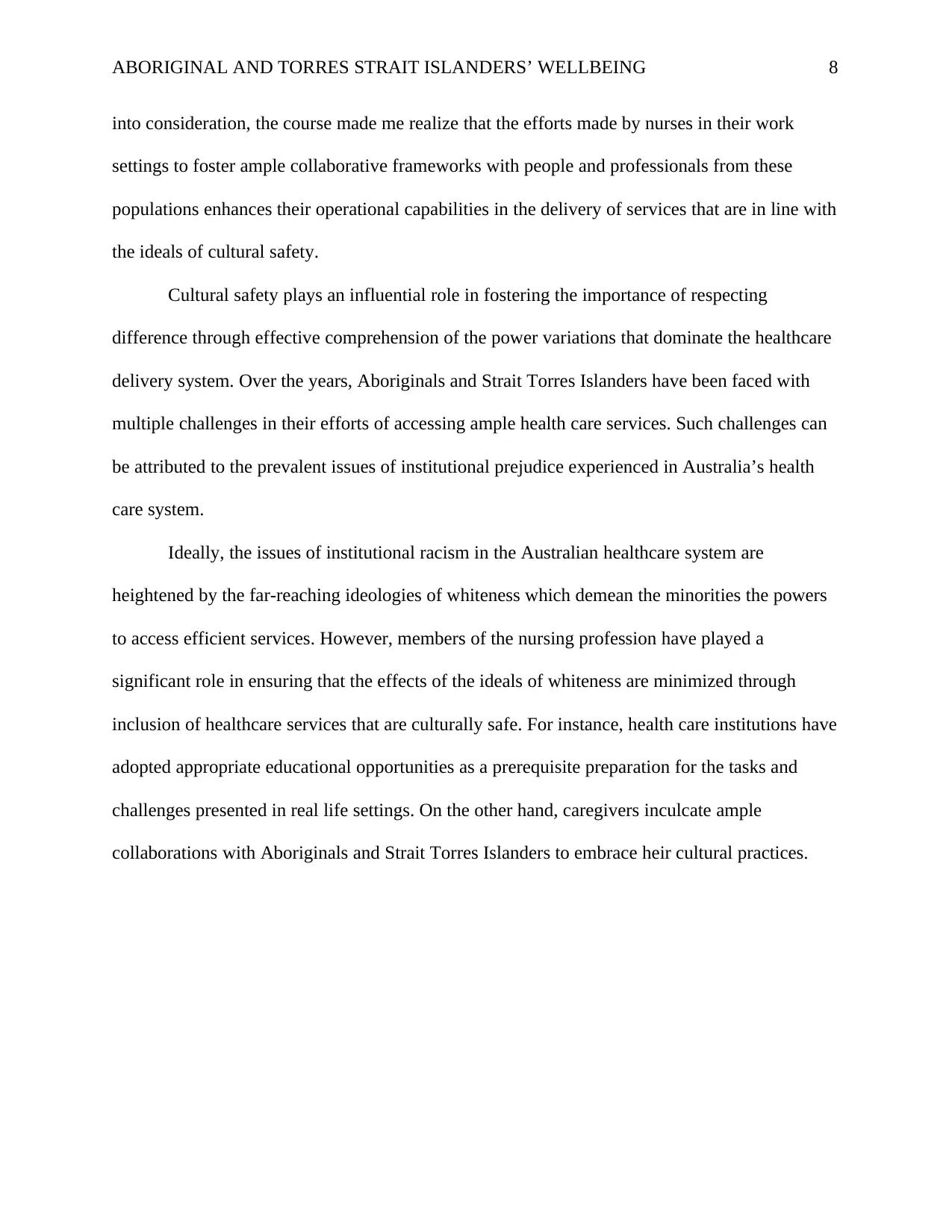
ABORIGINAL AND TORRES STRAIT ISLANDERS’ WELLBEING 8
into consideration, the course made me realize that the efforts made by nurses in their work
settings to foster ample collaborative frameworks with people and professionals from these
populations enhances their operational capabilities in the delivery of services that are in line with
the ideals of cultural safety.
Cultural safety plays an influential role in fostering the importance of respecting
difference through effective comprehension of the power variations that dominate the healthcare
delivery system. Over the years, Aboriginals and Strait Torres Islanders have been faced with
multiple challenges in their efforts of accessing ample health care services. Such challenges can
be attributed to the prevalent issues of institutional prejudice experienced in Australia’s health
care system.
Ideally, the issues of institutional racism in the Australian healthcare system are
heightened by the far-reaching ideologies of whiteness which demean the minorities the powers
to access efficient services. However, members of the nursing profession have played a
significant role in ensuring that the effects of the ideals of whiteness are minimized through
inclusion of healthcare services that are culturally safe. For instance, health care institutions have
adopted appropriate educational opportunities as a prerequisite preparation for the tasks and
challenges presented in real life settings. On the other hand, caregivers inculcate ample
collaborations with Aboriginals and Strait Torres Islanders to embrace heir cultural practices.
into consideration, the course made me realize that the efforts made by nurses in their work
settings to foster ample collaborative frameworks with people and professionals from these
populations enhances their operational capabilities in the delivery of services that are in line with
the ideals of cultural safety.
Cultural safety plays an influential role in fostering the importance of respecting
difference through effective comprehension of the power variations that dominate the healthcare
delivery system. Over the years, Aboriginals and Strait Torres Islanders have been faced with
multiple challenges in their efforts of accessing ample health care services. Such challenges can
be attributed to the prevalent issues of institutional prejudice experienced in Australia’s health
care system.
Ideally, the issues of institutional racism in the Australian healthcare system are
heightened by the far-reaching ideologies of whiteness which demean the minorities the powers
to access efficient services. However, members of the nursing profession have played a
significant role in ensuring that the effects of the ideals of whiteness are minimized through
inclusion of healthcare services that are culturally safe. For instance, health care institutions have
adopted appropriate educational opportunities as a prerequisite preparation for the tasks and
challenges presented in real life settings. On the other hand, caregivers inculcate ample
collaborations with Aboriginals and Strait Torres Islanders to embrace heir cultural practices.
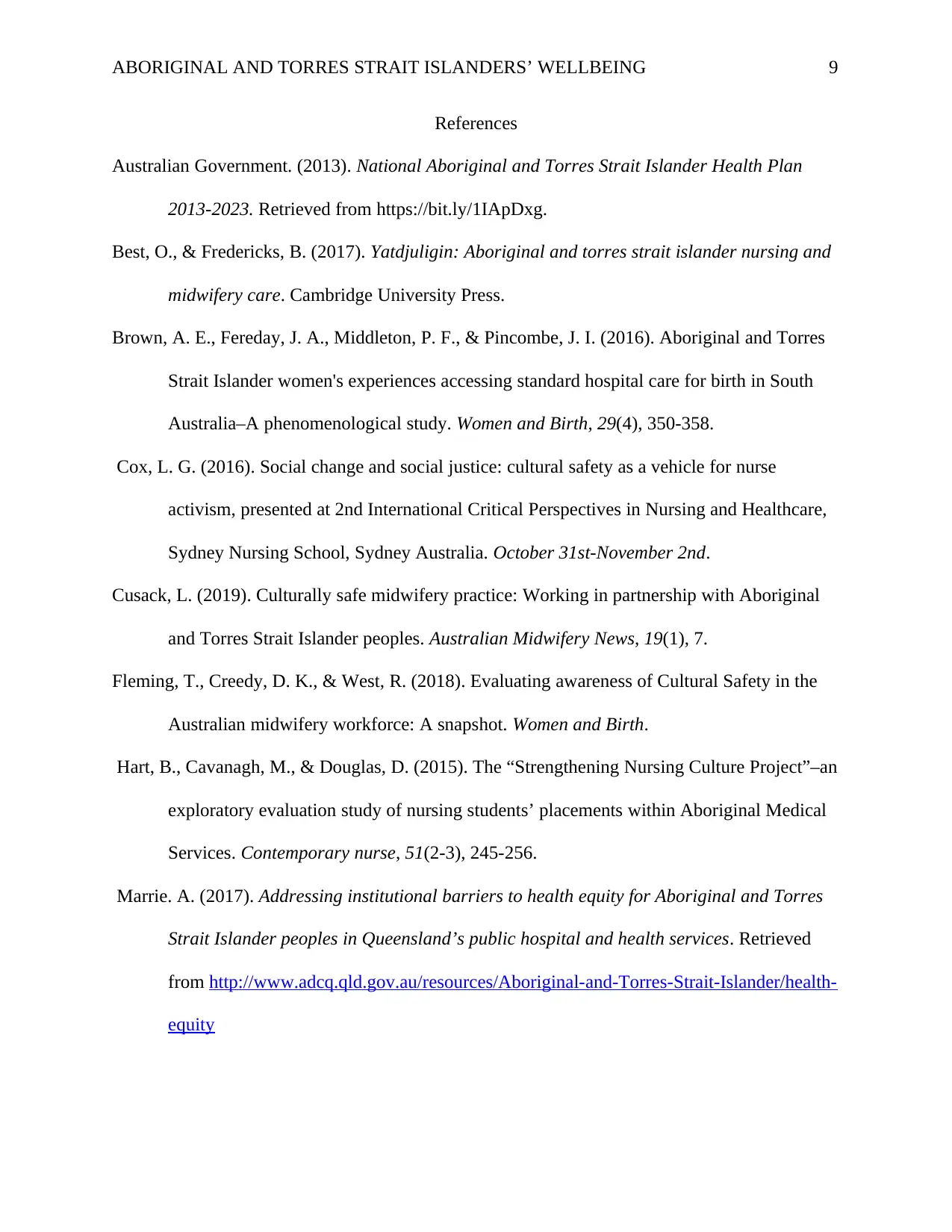
ABORIGINAL AND TORRES STRAIT ISLANDERS’ WELLBEING 9
References
Australian Government. (2013). National Aboriginal and Torres Strait Islander Health Plan
2013-2023. Retrieved from https://bit.ly/1IApDxg.
Best, O., & Fredericks, B. (2017). Yatdjuligin: Aboriginal and torres strait islander nursing and
midwifery care. Cambridge University Press.
Brown, A. E., Fereday, J. A., Middleton, P. F., & Pincombe, J. I. (2016). Aboriginal and Torres
Strait Islander women's experiences accessing standard hospital care for birth in South
Australia–A phenomenological study. Women and Birth, 29(4), 350-358.
Cox, L. G. (2016). Social change and social justice: cultural safety as a vehicle for nurse
activism, presented at 2nd International Critical Perspectives in Nursing and Healthcare,
Sydney Nursing School, Sydney Australia. October 31st-November 2nd.
Cusack, L. (2019). Culturally safe midwifery practice: Working in partnership with Aboriginal
and Torres Strait Islander peoples. Australian Midwifery News, 19(1), 7.
Fleming, T., Creedy, D. K., & West, R. (2018). Evaluating awareness of Cultural Safety in the
Australian midwifery workforce: A snapshot. Women and Birth.
Hart, B., Cavanagh, M., & Douglas, D. (2015). The “Strengthening Nursing Culture Project”–an
exploratory evaluation study of nursing students’ placements within Aboriginal Medical
Services. Contemporary nurse, 51(2-3), 245-256.
Marrie. A. (2017). Addressing institutional barriers to health equity for Aboriginal and Torres
Strait Islander peoples in Queensland’s public hospital and health services. Retrieved
from http://www.adcq.qld.gov.au/resources/Aboriginal-and-Torres-Strait-Islander/health-
equity
References
Australian Government. (2013). National Aboriginal and Torres Strait Islander Health Plan
2013-2023. Retrieved from https://bit.ly/1IApDxg.
Best, O., & Fredericks, B. (2017). Yatdjuligin: Aboriginal and torres strait islander nursing and
midwifery care. Cambridge University Press.
Brown, A. E., Fereday, J. A., Middleton, P. F., & Pincombe, J. I. (2016). Aboriginal and Torres
Strait Islander women's experiences accessing standard hospital care for birth in South
Australia–A phenomenological study. Women and Birth, 29(4), 350-358.
Cox, L. G. (2016). Social change and social justice: cultural safety as a vehicle for nurse
activism, presented at 2nd International Critical Perspectives in Nursing and Healthcare,
Sydney Nursing School, Sydney Australia. October 31st-November 2nd.
Cusack, L. (2019). Culturally safe midwifery practice: Working in partnership with Aboriginal
and Torres Strait Islander peoples. Australian Midwifery News, 19(1), 7.
Fleming, T., Creedy, D. K., & West, R. (2018). Evaluating awareness of Cultural Safety in the
Australian midwifery workforce: A snapshot. Women and Birth.
Hart, B., Cavanagh, M., & Douglas, D. (2015). The “Strengthening Nursing Culture Project”–an
exploratory evaluation study of nursing students’ placements within Aboriginal Medical
Services. Contemporary nurse, 51(2-3), 245-256.
Marrie. A. (2017). Addressing institutional barriers to health equity for Aboriginal and Torres
Strait Islander peoples in Queensland’s public hospital and health services. Retrieved
from http://www.adcq.qld.gov.au/resources/Aboriginal-and-Torres-Strait-Islander/health-
equity
⊘ This is a preview!⊘
Do you want full access?
Subscribe today to unlock all pages.

Trusted by 1+ million students worldwide

ABORIGINAL AND TORRES STRAIT ISLANDERS’ WELLBEING
10
Martin, J. M., White, J., Roberts, S., Haussegger, Z., Greenwood, E., Grant, K., & Haines, T.
(2019). Aboriginal Wellbeing: A Culturally Safe, Trauma-Informed Framework for
Health and Mental Health Services. In Mental Health Policy, Practice, and Service
Accessibility in Contemporary Society (pp. 107-133). IGI Global.
McGough, S., Wynaden, D., & Wright, M. (2018). Experience of providing cultural safety in
mental health to Aboriginal patients: A grounded theory study. International journal of
mental health nursing, 27(1), 204-213.
Middleton, R., Stephens, M., & Mackay, M. T. (2017). Incorporating the nursing and midwifery
Aboriginal and Torres Strait Islander health curriculum framework into a BN program.
Molloy, L., Lakeman, R., Walker, K., & Lees, D. (2018). Lip service: Public mental health
services and the care of Aboriginal and Torres Strait Islander peoples. International
journal of mental health nursing, 27(3), 1118-1126.
Slatyer, S., Cramer, J., Pugh, J. D., & Twigg, D. E. (2016). Barriers and enablers to retention of
Aboriginal Diploma of Nursing students in Western Australia: An exploratory descriptive
study. Nurse education today, 42, 17-22.
Zimmerman, P. A., Stringfellow, T., Rowland, D., Armstrong, V., & West, R. (2018). Review of
Aboriginal and Torres Strait Islander content within a Bachelor of Nursing. Collegian.
10
Martin, J. M., White, J., Roberts, S., Haussegger, Z., Greenwood, E., Grant, K., & Haines, T.
(2019). Aboriginal Wellbeing: A Culturally Safe, Trauma-Informed Framework for
Health and Mental Health Services. In Mental Health Policy, Practice, and Service
Accessibility in Contemporary Society (pp. 107-133). IGI Global.
McGough, S., Wynaden, D., & Wright, M. (2018). Experience of providing cultural safety in
mental health to Aboriginal patients: A grounded theory study. International journal of
mental health nursing, 27(1), 204-213.
Middleton, R., Stephens, M., & Mackay, M. T. (2017). Incorporating the nursing and midwifery
Aboriginal and Torres Strait Islander health curriculum framework into a BN program.
Molloy, L., Lakeman, R., Walker, K., & Lees, D. (2018). Lip service: Public mental health
services and the care of Aboriginal and Torres Strait Islander peoples. International
journal of mental health nursing, 27(3), 1118-1126.
Slatyer, S., Cramer, J., Pugh, J. D., & Twigg, D. E. (2016). Barriers and enablers to retention of
Aboriginal Diploma of Nursing students in Western Australia: An exploratory descriptive
study. Nurse education today, 42, 17-22.
Zimmerman, P. A., Stringfellow, T., Rowland, D., Armstrong, V., & West, R. (2018). Review of
Aboriginal and Torres Strait Islander content within a Bachelor of Nursing. Collegian.
1 out of 10
Related Documents
Your All-in-One AI-Powered Toolkit for Academic Success.
+13062052269
info@desklib.com
Available 24*7 on WhatsApp / Email
![[object Object]](/_next/static/media/star-bottom.7253800d.svg)
Unlock your academic potential
Copyright © 2020–2025 A2Z Services. All Rights Reserved. Developed and managed by ZUCOL.





